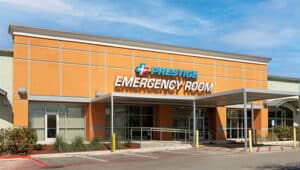As one of the main lines of defense in our most frightening and life-threatening moments, the emergency room has always been a hot topic. It shows up in television shows and debates about health care and all kinds of assertions get thrown around about it – some of which are very misleading. While we don’t expect everyone to be an expert on the topic, it’s vital that people are not scared away from emergency rooms by erroneous information. So, let’s take a look at some of the common misconceptions.
It’s not that exciting
Thanks mainly to film and TV, many people imagine the ER as a kind of war zone crowded with the bloodied victims of gunshots and car accidents. While such cases do, of course, happen, the truth is, car accident victims only make up about 26% of ER trauma cases, and gunshot victims a mere 4%. Falls and similarly mundane accidents are a much more common cause of traumatic injury, especially among the elderly who lack physical stability and mobility. And ER caregivers also tend to a wide variety of other ailments that, while not as visibly dramatic as physical injury, are nonetheless just as serious.
It’s not like the DMV
Ironically, many people also have an image of the ER as a slow-moving, ineffective place where doctors fumble their way through a backlog of patients who “don’t have actual emergencies.” There are multiple problems with this perception. First, the perception of emergency rooms as ineffective comes from the common idea that ER staff is somehow less qualified than other medical professionals. This is flatly false – ER physicians are board-certified and their nurses fully registered, the same as in any operating room, oncology department, or GP’s office.
Second, people’s frustration with wait times stems from the mistaken idea that an emergency room works on a “first-come-first-served” basis. Instead, it utilizes a triage model that prioritizes serious conditions first. What counts as “immediately serious” may not be obvious to the casual observer – again, people visit the ER for far more than just gunshot wounds or head trauma. What is more, ERs have started to widely implement “systems engineering” methods used by other industries to help reduce wait times – 70% of ER patients receive care within an hour of arrival, and 40% within 15 minutes.
Third, despite the common perception that ERs are crowded with people making “unnecessary visits,” the American College of Emergency Physicians states that only about 3.3% of ER visits can be definitely categorized as avoidable or unnecessary. It is important to remember that many people visit the ER for conditions that initially appear serious even though they are not. Conversely, many ER patients have serious conditions that are not immediately apparent to others in the waiting room.
It’s not skyrocketing the cost of healthcare
On a similar note, there is a widespread belief that ER visits are a significant financial drain on the healthcare industry at large. While the numbers are impressive at first glance – an estimate of over $7 trillion spent for 2019, for example – national studies indicate that ER expenses only account for about 5-10% of overall healthcare costs. What is more, ER visits often catch conditions that would become far more serious and expensive further down the line, meaning that a comprehensive and open system of emergency treatment saves money in the long run.
It’s not full of pandemic patients
Of all the misconceptions about emergency rooms, perhaps the most recent and most problematic is the idea that they are crawling with coronavirus. Avoiding contact with the virus has understandably been a big motivator for people to stay home – but with the ironic effect of preventing them from seeking out necessary care for other conditions. ERs across the country have reported a staggering 50% decrease in daily visits since the pandemic, meaning that likely, millions of serious conditions have gone untreated.
Yet even at the pandemic’s peak, only about 8% of ER visits nationally were due to Covid-19 – making it clear that the emergency room is not the coronavirus hothouse that many people fear. Regardless of the numbers, emergency rooms everywhere have added strict protocols for sanitization, PPE use, and the screening and isolation of Covid patients – all in addition to the rigorous sanitation procedures they already have.
A visit to the ER is seldom enjoyable, of course. But as it can quite literally be a matter of life and death, it is important to debunk the myths and misconceptions that may steer people away from it. Emergency rooms have always been an essential, effective service, and in some ways, they are even more important today.












